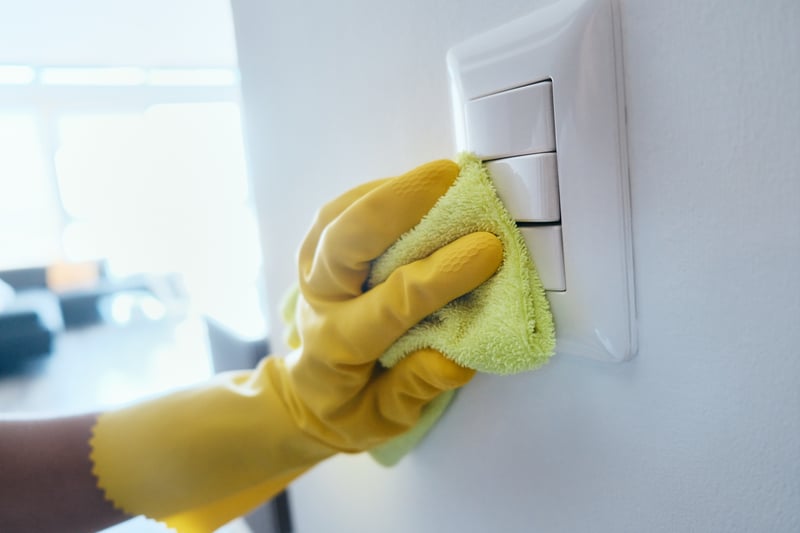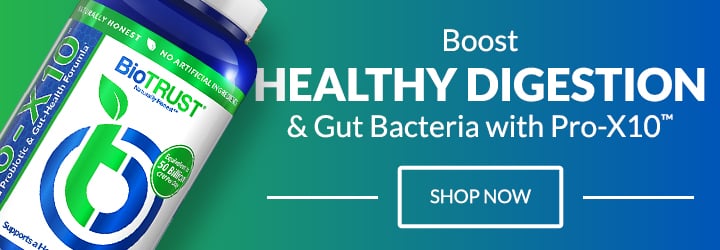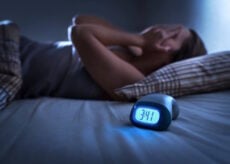The Most Common Places Germs Are Hiding in Your Home

Fun fact: Bacteria and fungi can live on dry surfaces for months. Viruses, which are the most common causes of infectious diseases like those that cause the common cold, tend to remain infectious (on surfaces) for a day or so. Other types of viruses, including influenza and coronaviruses, have a shorter life span on surfaces — usually a matter of hours. The type of surface makes a difference, as viruses tend to remain infectious longer on stainless steel, plastic, and other hard surfaces than on fabric and soft surfaces.
While most disease is spread from direct droplets (e.g., a person sneezes or coughs in your vicinity) or direct contact (e.g., you shake hands with someone who is infected), surfaces that get a lot of cross-contact can be hiding germs for hours to days.
If you don’t want to get sick (who’s got time for that?), you’re right to stop and contemplate that door handle or other high-contact surface before touching, as that’s a fantastic surface to hang out on from the perspective of a germ.
Yet, even within our own homes, germs can thrive. In fact, the dirtiest places within your home include:
- Doorknobs and cabinet handles
- Digital devices (e.g., phones, tablets, computer keyboards, and remote controls)
- Sink faucet handles
- Toilet handles
- Kitchen sponges (the most contaminated of them all)
- Towels
- Toothbrush holders
While it’s essential to know where germs are residing, it’s arguably even more important to know how to get rid of them. Cleaning may not be the most fun chore, but you and your family can enjoy greater health by ensuring it’s part of your routine. And there are specific places (often forgotten or ignored) within your home that you’ll want to prioritize to better protect everyone who lives there.
Quick Caveat: This article is for reference only. The statements are not intended to be used to prevent, treat, or cure any disease or illness. Please consult a medical professional and the CDC for complete information on how to correctly disinfect or sanitize, especially if you have been ill. This article is intended to provide an overview of different ways to help keep a cleaner home, but they may not all be the best options for every situation.
Now, let’s investigate where those germies are hiding…
The Most Common Places Germs Are Hiding in Your Home
1. Doorknobs and Switch Plates
Even if you wipe down surfaces daily, chances are pretty good that you don’t even think about how often you open doors, cabinets, or appliances or turn on and off lights. Yet these are all surfaces that are common contact points. And every time they’re touched, you’re moving the germs, dirt, and “ick” from one place to another (often directly onto your own hands).
How to Clean Doorknobs & Switch Plates
Because these surfaces are so high touch, they should be cleaned at least twice a week, and more often if someone in the household has been sick. Start by cleaning the surface using soap and water. Then, simply spray or wipe the surface (make sure you get even the hard-to-reach spaces) with a disinfectant. Allow the disinfectant to sit on the surface for 10 minutes and then wipe it off with a clean, dry cloth.
2. Kitchen Hotspots
Of course, right? After all, this is where you prepare and cook food, and it’s also often where people eat. It’s not surprising that this is where germs also gather.
Countertops and sinks are obvious places to keep clean. Yet, some of the top spots for hidden germs include refrigerator handles, stove knobs, and microwave handles and touchpads. Don’t forget to deep clean your cutting board and coffee maker, too.
How to Clean Kitchen Germs
If you practice good handwashing hygiene (i.e., scrubbing hands with soap and water for at least 20 seconds, especially after handling raw meat), you can get away with cleaning these surfaces with a disinfectant weekly (at least). Don’t just grab one cloth and go, though. You’ll want to ensure you have a clean cloth for each surface, so you’re not spreading the germs from one surface to the next.
Surfaces like cutting boards and coffee makers need a deeper clean. Plastic cutting boards can just be placed in the dishwasher after every use. For wood cutting boards, which are actually safer when properly maintained, grab a cleaning brush or sponge, dish soap, and 3% hydrogen peroxide. Start by rinsing off any food, and then use a good clean brush or sponge with soap to scour the surface. Then, disinfect the surface by pouring hydrogen peroxide over it. Let it sit and fizz for up to ten minutes before rinsing with hot tap water. (Don’t let it stand any longer, however, as the wood could warp.)
If at all possible, have at least two cutting boards: One for cutting fresh fruits and vegetables and the other for slicing raw meat to help prevent contamination of raw foods.
For your coffee pot, wash out any removable parts, like the pot and basket, with dish soap and hot water after every use. Then, leave the lid open, so the water has a chance to evaporate when not in use.
The full coffee maker needs a deep clean every one to six months (depending on how often it’s used). To decalcify your coffee pot, use equal parts white vinegar and water. Brew it halfway, then allow it to rest for 30 minutes. Then, turn it back on to allow it to finish brewing. Dump out the vinegar and water and rinse well by brewing a full pot of clean water. If it still smells like vinegar, brew another pot of clean water.
3. Kitchen Sponges and Dish Towels
You use it, let it air dry, and get on with your life, often forgetting the last time it was washed. Unfortunately, these surfaces are some of the most contaminated of all.
How to Clean Kitchen Sponges & Dish Towels
For any sponges, make sure they’re damp and just pop them in the microwave for a full minute or two. Do this daily or with each use to help kill bacteria. And replace them often—every other week at the longest.
For dishcloths and hand towels, change them anytime they’re dirty and at least a few times a week. Wash them in hot water with a quality detergent and add a cup of white vinegar, a cup of 3% hydrogen peroxide (be careful, though, as this can also bleach some fabrics), oxygen bleach, or borax.
While you’re at it, don’t forget to clean your kitchen sink. Keep a spray bottle of disinfectant at the ready to spritz daily. Let it sit and wipe it down and rinse with hot water.
4. Bathroom Hotspots
It’s where we clean all parts of our bodies and do our “unmentionables,” and it’s also often humid and wet, which makes it a perfect breeding ground for germs.
How to Clean Bathroom Hotspots
Wipe down surfaces like the sink and countertop, tub/shower, and toilet handle daily, and then clean it completely every week—including washing the floor. Don’t forget your bathroom towels, which should be washed and dried each week.
Once a month, toss your shower curtain and liner in the wash with a towel or two along with vinegar, baking soda, or a gentle laundry detergent (pick only one) in warm (not hot) water. Then, either line-dry it or hang it back over the shower or tub to dry.
Toothbrush holders also need to be disinfected at least weekly, and toothbrushes need to be replaced every three to four months (and anytime you’ve been sick). Store them on the opposite side of the bathroom, away from the toilet, in an upright position to allow the water to drain from the bristles.
5. Bedrooms
Whether you settle down for sleep alone, with a partner, or with a pet, you’re never really alone. Beds are full of dust and dust mites, dander, pollen, and potentially, fungi. Sounds cozy, right?
How to Clean Bedrooms
Once a week, wash all of your bedding in hot water. Then, vacuum not only the floors, but your mattress as well. After you’re done vacuuming, don’t let the dust, dander, hair, etc., just sit in the vacuum. Take it out of the house to an outdoor trash can or dumpster.
6. Smartphones
What goes with you everywhere and is constantly being touched? For most of us, it’s our smartphones. One study, for instance, found that people touch their phones over 2,600 times per day on average during over 75 separate sessions. In fact, the CDC considers the smartphone to be the most commonly touched surface. And since it’s with you everywhere, it gets a lot of exposure to germs.
How to Clean Smartphones
If you’re not currently cleaning your phone at least daily, now is a great time to start. Of course, as with any electronic device, you need to be careful. Avoid submerging any products or getting moisture into any opening and avoid harsh chemicals like bleach. Alcohol wipes are generally recommended, but they may not be suitable for your smartphone. For specifics on how to clean your device, please go directly to the manufacturer’s website, as different devices require different cleaning instructions.
If you use a smartphone case and screen cover, you may be able to simply remove the phone and wash the case with soap and hot water. Just make sure it isn’t the type of case that also contains electronic devices.
Best Products for Hiding Germs
Finding a cleaner is as simple as grabbing a bottle on the shelf, right? The biggest difference is just cost… Nope. Unfortunately, many common cleaning products are flat-out dangerous. One study, for example, found that chemical cleaning products could be as harmful to lung function as smoking a pack of cigarettes every day.
During times when contagions are high, the benefits may outweigh the risk, but there are simple, non-toxic cleaners that make routine cleaning more enjoyable that still clean and disinfect. Products to consider include:
- Hydrogen peroxide: Kills mold and mildew; sanitizes counters, cutting boards, doorknobs, and handles (Use with caution, as, like bleach, it may damage colors and some surfaces, though it also removes tough stains. Hydrogen peroxide is also very light sensitive, so always store it in an opaque container in a cool, dark place.)
- White vinegar: Kills mold and mildew, removes soap scum, and can sanitize kitchen surfaces and cutting boards (Add baking soda or borax to scour tough stains or dried-on food.)
- Steam
- Alcohol (look for products that are 140 proof or higher, so they’re 70+% alcohol, such as Everclear, Spirytus vodka, or Golden Grain, or at least 70% isopropyl/rubbing alcohol)
- Castile soap
- Lemon juice and/or essential oils to help everything smell fresher (There’s debate on how much additional cleaning power they add, but they can make the cleaning process more enjoyable because they smell so nice.)
If you are using more standard cleaning products, make sure you have plenty of ventilation (open up those windows and doors) and rinse the surfaces completely. In addition, avoid using bleach and ammonia anywhere near each other because, when combined, they create deadly fumes.
How to Make Your Own Germ-Fighting Cleaners
There are plenty of less-toxic options available at the store, but making your own can be done in five minutes, often for less money. For a simple disinfecting all-purpose spray, mix:
- 1 ½ cups of at least 100-proof alcohol or higher, such as vodka or Everclear, which is available in 120, 151, and 190 proof (You can also use isopropyl rubbing alcohol, but that can be more damaging to surfaces, so spot test your surface before using.)
- ½ cup white distilled vinegar
- Optional: 25 to 50 drops of your favorite essential oil
Another option is to have two separate bottles, one with vinegar and one with hydrogen peroxide. Spray one ingredient and let it sit for five minutes. Wipe the surface down and then spray with the second ingredient, again waiting five minutes before wiping the surface clean. Don’t mix the hydrogen peroxide with the vinegar, though, as this makes them less stable and less effective.
If you are cleaning/disinfecting electronic devices (including light switches, remote controls, and phones), spray onto a cloth first (instead of on the device directly) and ensure you don’t get any moisture inside the device.
To help clean objects on the go (including your purse, backpack, briefcase, and steering wheel, and gear shift), you may want to bring some cleaning supplies with you. Store-bought disinfectant wipes are a great option, but right now, they can be difficult to come by. Fortunately, you can make your own with three simple ingredients: Alcohol, hydrogen peroxide, and the essential oil(s) of your choice.
You’ll need a large measuring cup and an opaque pitcher or jar with an airtight lid. To make:
- Mix 3 cups of 100-proof or above alcohol with 1 tablespoon hydrogen peroxide (3%) and 3 or 4 drops of dish soap. (You can also add your favorite essential oils for scent.) Mix it up.
- Fill your pitcher or glass jar with high-quality paper towels, shop cloths, napkins, or reusable washcloths.
Slowly and carefully pour the solution over the wipes, getting all of the wipes wet. There should still be liquid at the bottom of your jar, and you may want to swish it around to ensure your wipes are saturated with the solution before use.
After use, throw away your used wipe, or if using a washcloth or reusable towel, place in a separate container until you can wash it later.
Hidden Germs: A Wrap-Up
While keeping your home clean is important, keeping your hands clean is even more important. Scrub with soap and warm water for 20 seconds to ensure your hands are really clean, especially after you’ve used the bathroom and before preparing food, eating, or touching your face.
And avoid touching your face, especially in public, but also after touching the often-germ-infested surfaces described above. If you can’t wash your hands immediately, make sure you use a good hand sanitizer.
Finally, to help prevent germs from walking into the house, consider removing your shoes at the door and leaving them there.
You may never be able to remove all of the disease-causing germs from your home, but with regular cleaning of the surfaces above, you may be able to turn the odds in your favor.





 7 Signs Your Body is Seriously Low on Collagen (not just wrinkles)
7 Signs Your Body is Seriously Low on Collagen (not just wrinkles) Health Expert: "Turmeric Doesn't Work (unless...)"
Health Expert: "Turmeric Doesn't Work (unless...)" 3 Warning Signs Your Probiotic Supplement is a Total Waste
3 Warning Signs Your Probiotic Supplement is a Total Waste

